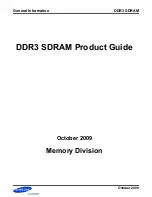
Battery cycle life
Battery cycle life is the total number of discharge-charge cycles (Figure 1) a battery yields before it
can no longer hold a useful amount of charge. Estimating the cycle life of a rechargeable Li-Ion
battery is difficult because cycle life is affected by the average operating temperature of the battery
and its energy discharge rate. Basically, higher temperatures and higher energy discharge rates
decrease battery cycle life. The operating temperature of the battery depends on the air temperature
as well as the heat generated by the notebook itself and by its immediate environment, such as a
docking station. The energy discharge (drainage) rate depends on the type of applications running
on the notebook and by its power management settings. For example, running compute-intensive
applications such as CAD, gaming, and DVD movies drains the battery faster and decreases its cycle
life more than running word processing applications.
Figure 1.
A cycle for a rechargeable lithium-ion battery is the cumulative amount of discharge approximately equal to its full
charge capacity. For example, 10 occurrences of a 10% depth of discharge or 2 occurrences of a 50% depth of discharge
represent one cycle.
Battery capacity
Battery capacity is expressed in ampere-hours (Ah). Battery energy, expressed in watt-hours (Wh), is
the product of the battery capacity (Ah) and the battery voltage (V). The operating voltage range of a
Li-Ion battery pack remains relatively constant throughout its useful life; however, its capacity begins to
decrease in a roughly linear manner as soon as it is put into service. New batteries are classified by
their rated capacity. Over time, the actual battery capacity decreases due to electrochemical
inefficiencies within each cell. This loss in capacity (aging) is irreversible; it cannot be restored by
cycling the battery. Gradually, less and less active material is available within each cell to
electrochemically store a charge. Consequently, the user experiences reduced computer run time.
A practical way to express the actual capacity of a battery over time is called full charge
capacity (FCC). FCC is expressed as a percentage of the initial rated capacity of the battery. FCC is
influenced by the typical discharge load on the battery and by the user profile. Under normal
discharge loads, Li-Ion batteries have a lifespan of between 300 and 500 cycles. With moderate use,
Li-Ion batteries are expected to deliver approximately 80% of their rated capacity after 300 cycles or
about one year of use (Figure 2). This estimate covers typical users who completely cycle the battery
each working day by running low to medium power applications (word processing, e-mail, and
spreadsheets) in wired or wireless modes.
Figure 2.
Full charge capacity with moderate use is about 80% after 300 cycles.
3
























